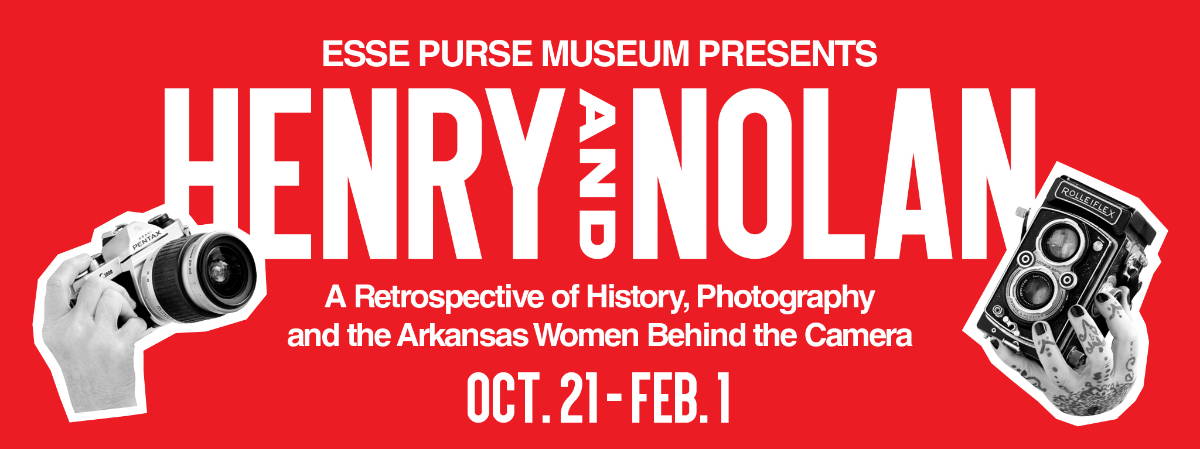Currently On Display
Here at ESSE, we’re always striving to bring new and interesting exhibits on the objects, moments, and memories that make up part of the American woman’s story. Take a moment to check out what we currently have housed here at the museum.

“Henry and Nolan”
A Retrospective of History, Photography,
and the Arkansas Women Behind the Camera
OCTOBER 21 - FEBRUARY 1, 2025
A Century Of Women And Handbags 1900-1999
More than just a fashion history, this ongoing exhibit showcases a compellingly intimate look at the evolution of the 20th-century American woman – decade by decade – through her handbags and the items she carried with her everyday. What does your handbag and its contents say about you?This exhibit is on permanent display at ESSE. Also, check out our temporary exhibits.
The 1900s
At the dawn of the century, American women were beginning to experiment with newfound freedoms, and as this new liberation pulled women out of the house, handbags changed from dispensable accessories to daily necessities. As her purse contents showed, the turn-of-the-century woman had one foot in the 19th century and another in the 20th.
The 1910s
Though American women didn’t grow into their federal right to vote until 1920, the teen years of the century were in many ways as tumultuous as teen years in a modern household. As the country outgrew the teen years, the purse was an indispensable part of a woman’s fashion ensemble, as important as her shoes, hat and gloves.
The 1920s
The 1920s roared in, ran wild with prosperity, then crashed and burned as the economy collapsed, ruining a decade-long cocktail party that began with women gaining the right to vote. The purse, by now a staple of every put-together woman’s wardrobe, took on a new life in the ’20s as fashion showpiece, and even the average woman could afford handbags in varying styles.
The 1930s
During the lean, hard years of the Great Depression, fashion for most reflected the soberness of the real world. Except in high society and Hollywood, where flamboyantly fashionable clutches still reigned, purses began to reflect a new seriousness; form, function and sturdiness grew in importance, and women turned to the idea of owning just one “good” handbag.
The 1940s
Fashion retreated to the back burner with wartime rationing in the early ’40s. Purses became larger and more practical to accommodate the new self-sufficient woman, symbolized by Rosie the Riveter and her can-do attitude. But women breathed a collective sigh of fashion relief in 1947, when French designer Christian Dior’s “New Look” brought elegance and femininity – and the elegant clutch purse – back into full bloom.
The 1950s
Hemlines and feminine independence dropped in the ’50s as post-war prosperity returned most women to domesticity and motherhood. Many women paid slavish attention to fashion magazines and fashion rules, and matching gloves, shoes and purses were de rigueur. As for purses, styles ran the gamut from uber-expensive designer leather to box purses to fun and quirky Lucite in rainbows of colors.
The 1960s
The 1960s began innocuously as a continuation of the contented, conservative 1950s, but mid-decade, Vietnam and the youth movement created societal rifts. When slacks emerged as haute couture, most women embraced them with open arms and dared anyone to force them back into dresses. Purses in the 1960s were as diverse as political opinions and heavily influenced by the youth.
The 1970s
The optimism of the previous decade disappeared as continuing issues created a sense of disillusionment during the early years of the 1970s. In response, the hippie movement became global campaign for change and highly fashionable in the new decade. As dress codes relaxed, casual unisex fashions and jeans were adopted by nearly everyone. At the same time, feminists rebelled against the oppressive fashion system by rejecting cosmetics, bras and bags. As women entered the workforce in unprecedented numbers, they demanded practical handbags that were functional as well as attractive. The larger, leather shoulder bag fit the bill and became the purse of the decade. Bags sparkled under the disco ball, while designers labels carried the purse into the next decade.
The 1980s
The 1980s introduced the power mom with big shoulder pads who could have it all: beautiful appearance, lovely home, well-mannered kids, powerful career. But the ’80s superwoman’s high-stress, multi-faceted life led her to rely ever more on her purse. Having it all often meant carrying it all, and logo-adorned designer purses began to be advertised as not only vital accessories but desirable objects in their own right.
The 1990s
A backlash against ’80s power-dressing turned down the volume on fashion for women in the 1990s. For working women, tailored suits (skirt or pants) were back, and unisex khakis and jeans ruled casual wear. As the decade progressed, “good” feminine accessories were back, and women tended to spend more on designer bags than on clothes. A sturdy leather purse by Dooney & Burke made a statement and would last for years.

